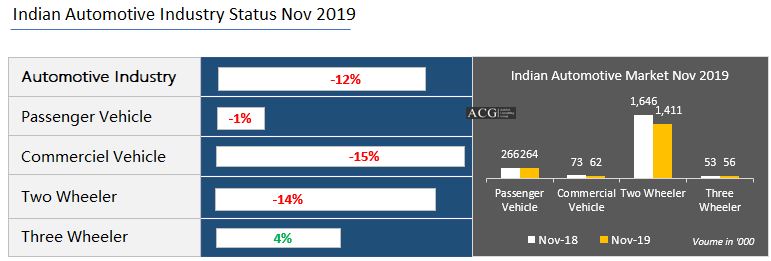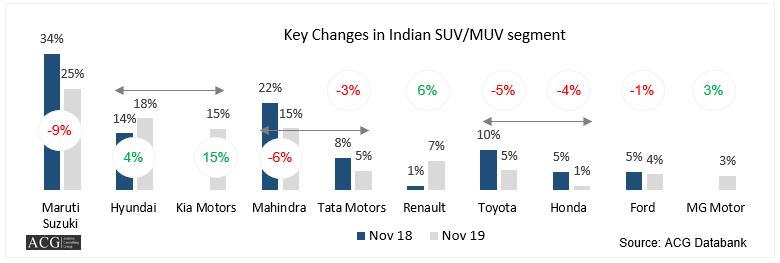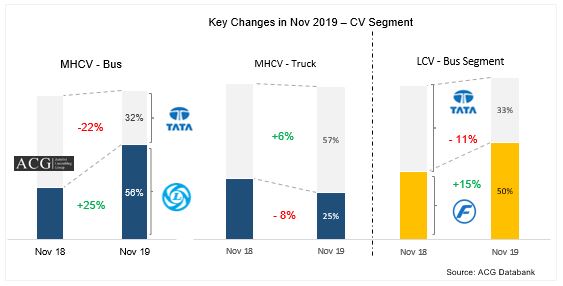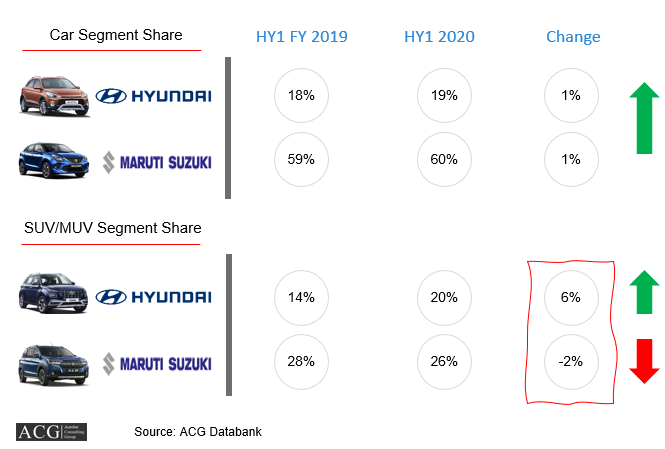Every Year ACG released most detail and critical Research Report on Indian Automobile Industry Report which covers all major vertical of Industry including Electric Vehicle and Govt policies to promote it. The report contains Historical Trend and next 5 years forecast. Indian is expected to be among the Globally top 3 markets by 2030 by touching USD 270 billion. We analyzed multiple factors which influenced the Automotive sector. This also helps the foreign and Indian companies which are planning to invest in the Automobile sector. The report is available on subscription-based also. The Monthly and Quarterly subscription option is available to get every pulse of the industry movement.
Each chapter gives qualitative analysis, Challenges, Opportunities, and Market Drivers also. Additional information like Doing business in India, Finding a partner in India, Consumer buying behavior, Product launching strategy, Marketing & Branding Strategy, Digital solution, Sales Planning, and Business etiquette in India.
Table of Content of the report:
1 Summary
2 Automobile Industry Overview
3 Methodology and Limitation of Study
4 Country Analysis – India
4.1. Politics
4.2. Economy
4.3. Risk
4.4. Regulation
4.5. Business
4.6. Industry
4.7. Culture
5. Auto Industry Statistics Analysis – Since 2013 to 2017
6. Indian Automotive Industry Overview and Segment Analysis
7. Passenger Vehicle
7.1. Car
7.1.1. Market Size (Unit & Value)
7.1.2. Segment Share
7.1.3. Growth
7.1.4. Latest updates
7.1.5. New Product Launched
7.2. UV/SUV
7.2.1. Market Size (Unit & Value)
7.2.2. Segment Share
7.2.3. Growth
7.2.4. Latest updates
7.2.5. New Product Launched
7.3. Van
7.3.1. Market Size (Unit & Value)
7.3.2. Segment Share
7.3.3. Growth
7.3.4. Latest updates
7.3.5. New Product Launched
8. Commercial Vehicle
8.1. Medium & Heavy Commercial Vehicle
8.1.1. Market Size (Unit & Value)
8.1.2. Segment Share
8.1.3. Growth
8.1.4. Latest updates
8.1.5. New Product Launched
8.2. Light Commercial vehicle
8.2.1. Market Size (Unit & Value)
8.2.2. Segment Share
8.2.3. Growth
8.2.4. Latest updates
8.2.5. New Product Launched
9. Two-Wheeler Analysis
9.1. Market Size (Unit & Value)
9.2. Segment Share
9.3. Growth
9.4. Latest updates
9.5. New Product Launched
10. Scooter (Unit & Value)
10.1. Sales Volume
10.2. Segment Share
10.3. Growth
11. Motorcycle (Unit & Value)
11.1. Sales Volume
11.2. Segment Share
11.3. Growth
12. Moped (Unit & Value)
12.1. Sales Volume
12.2. Segment Share
12.3. Growth
13. Three-Wheeler
13.1. Market Size (Unit & Value)
13.2. Segment Share
13.3. Growth
14. Three-Wheeler Passenger Vehicle
14.1. Sales Trend Analysis
14.2. Segment Share
14.3. Growth Analysis
14.4. Segment Share
15. Three-Wheeler Cargo Vehicle
15.1. Sales Trend Analysis
15.2. Production Trend Analysis
15.3. Export Trend Analysis
15.4. Segment Share
16. Passenger Vehicle Detail Analysis – Market Trend, Market Share and Growth
16.1. Market Size (Unit & Value)
16.2. Segment Share
16.3. Growth
16.4. Latest updates
16.5. New Product Launched
16.6. OEMs Sales, Market Share, and Growth Analysis
16.6.1. FIAT
16.6.1.1. Company Overview
16.6.1.2. Sales Volume
16.6.1.3. Market Share movement
16.6.1.4. Product Portfolio and Analysis
16.6.1.5. Production plant
16.6.2. Force Motors
16.6.2.1. Company Overview
16.6.2.2. Sales Volume
16.6.2.3. Market Share movement
16.6.2.4. Product Portfolio and Analysis
16.6.2.5. Production plant
16.6.3. Ford India
16.6.3.1. Company Overview
16.6.3.2. Sales Volume
16.6.3.3. Market Share movement
16.6.3.4. Product Portfolio and Analysis
16.6.3.5. Production plant
16.6.4. Hindustan Motor Fin. Corp.Ltd/Hindustan Motors Ltd
16.6.4.1. Company Overview
16.6.4.2. Sales Volume
16.6.4.3. Market Share movement
16.6.4.4. Product Portfolio and Analysis
16.6.4.5. Production plant
16.6.5. Honda
16.6.5.1. Company Overview
16.6.5.2. Sales Volume
16.6.5.3. Market Share movement
16.6.5.4. Product Portfolio and Analysis
16.6.5.5. Production plant
16.6.6. Hyundai
16.6.6.1. Company Overview
16.6.6.2. Sales Volume
16.6.6.3. Market Share movement
16.6.6.4. Product Portfolio and Analysis
16.6.6.5. Production plant
16.6.7. Isuzu Motors
16.6.7.1. Company Overview
16.6.7.2. Sales Volume
16.6.7.3. Market Share movement
16.6.7.4. Product Portfolio and Analysis
16.6.7.5. Production plant
16.6.8. Mahindra & Mahindra
16.6.8.1. Company Overview
16.6.8.2. Sales Volume
16.6.8.3. Market Share movement
16.6.8.4. Product Portfolio and Analysis
16.6.8.5. Production plant
16.6.9. Maruti Suzuki
16.6.9.1. Company Overview
16.6.9.2. Sales Volume
16.6.9.3. Market Share movement
16.6.9.4. Product Portfolio and Analysis
16.6.9.5. Production plant
16.6.10. Nissan Motor
16.6.10.1. Company Overview
16.6.10.2. Sales Volume
16.6.10.3. Market Share movement
16.6.10.4. Product Portfolio and Analysis
16.6.10.5. Production plant
16.6.11. Renault
16.6.11.1. Company Overview
16.6.11.2. Sales Volume
16.6.11.3. Market Share movement
16.6.11.4. Product Portfolio and Analysis
16.6.11.5. Production plant
16.6.12. Skoda
16.6.12.1. Company Overview
16.6.12.2. Sales Volume
16.6.12.3. Market Share movement
16.6.12.4. Product Portfolio and Analysis
16.6.12.5. Production plant
16.6.13. Tata Motor
16.6.13.1. Company Overview
16.6.13.2. Sales Volume
16.6.13.3. Market Share movement
16.6.13.4. Product Portfolio and Analysis
16.6.13.5. Production plant
16.6.14. Toyota
16.6.14.1. Company Overview
16.6.14.2. Sales Volume
16.6.14.3. Market Share movement
16.6.14.4. Product Portfolio and Analysis
16.6.14.5. Production plant
16.6.15. Volkswagen
16.6.15.1. Company Overview
16.6.15.2. Sales Volume
16.6.15.3. Market Share movement
16.6.15.4. Product Portfolio and Analysis
16.6.15.5. Production plant
16.6.16. Others
17. Commercial Vehicle Analysis
17.1. Total Indian CV Industry Market size – 2012 to 2017 (Unit & Value)
17.2. CV Market Share Analysis in Indian Automobile Industry
17.3. Sales Statistics
17.4. Production Statistics
17.5. Export Statistics
17.6. Growth Analysis
17.7. Key Market Drivers
18. Segment Analysis
18.1. Indian Commercial Vehicles: Market Classification
18.2. OEM Strategy Analysis
18.2.1. AMW Motors (Not in Operation)
18.2.1.1. Company Overview
18.2.1.2. Sales Volume
18.2.1.3. Market Share movement
18.2.1.4. Product Portfolio and Analysis
18.2.1.5. Production plant
18.2.2. Ashok Leyland
18.2.2.1. Company Overview
18.2.2.2. Sales Volume
18.2.2.3. Market Share movement
18.2.2.4. Product Portfolio and Analysis
18.2.2.5. Production plant
18.2.3. Force Motors
18.2.3.1. Company Overview
18.2.3.2. Sales Volume
18.2.3.3. Market Share movement
18.2.3.4. Product Portfolio and Analysis
18.2.3.5. Production plant
18.2.4. Isuzu Motors
18.2.4.1. Company Overview
18.2.4.2. Sales Volume
18.2.4.3. Market Share movement
18.2.4.4. Product Portfolio and Analysis
18.2.4.5. Production plant
18.2.5. Mahindra
18.2.5.1. Company Overview
18.2.5.2. Sales Volume
18.2.5.3. Market Share movement
18.2.5.4. Product Portfolio and Analysis
18.2.5.5. Production plant
18.2.6. Maruti Suzuki
18.2.6.1. Company Overview
18.2.6.2. Sales Volume
18.2.6.3. Market Share movement
18.2.6.4. Product Portfolio and Analysis
18.2.6.5. Production plant
18.2.7. Piaggio Vehicles Pvt Ltd
18.2.7.1. Company Overview
18.2.7.2. Sales Volume
18.2.7.3. Market Share movement
18.2.7.4. Product Portfolio and Analysis
18.2.7.5. Production plant
18.2.8. SML Isuzu Ltd
18.2.8.1. Company Overview
18.2.8.2. Sales Volume
18.2.8.3. Market Share movement
18.2.8.4. Product Portfolio and Analysis
18.2.8.5. Production plant
18.2.9. Tata Motors Ltd
18.2.9.1. Company Overview
18.2.9.2. Sales Volume
18.2.9.3. Market Share movement
18.2.9.4. Product Portfolio and Analysis
18.2.9.5. Production plant
18.2.10. VECVs – Eicher
18.2.10.1. Company Overview
18.2.10.2. Sales Volume
18.2.10.3. Market Share movement
18.2.10.4. Product Portfolio and Analysis
18.2.10.5. Production plant
18.2.11. VECVs – Volvo
18.2.11.1. Company Overview
18.2.11.2. Sales Volume
18.2.11.3. Market Share movement
18.2.11.4. Product Portfolio and Analysis
18.2.11.5. Production plant
18.3. Medium & Heavy Commercial Vehicle Analysis
18.3.1. Market Size and Trend Analysis
18.3.2. Segment and Market Share Analysis
18.3.3. Growth Analysis
18.3.4. Key players
18.3.5. OEMs Strategy Analysis
18.3.6. Tata Motors
18.3.6.1. Company Overview
18.3.6.2. Sales Volume
18.3.6.3. Market Share movement
18.3.6.4. Product Portfolio and Analysis
18.3.7. AMW (Not in Operation)
18.3.7.1. Company Overview
18.3.7.2. Sales Volume
18.3.7.3. Market Share movement
18.3.7.4. Product Portfolio and Analysis
18.3.8. VECV – Eicher
18.3.8.1. Company Overview
18.3.8.2. Sales Volume
18.3.8.3. Market Share movement
18.3.8.4. Product Portfolio and Analysis
18.3.9. VECV – Volvo
18.3.9.1. Company Overview
18.3.9.2. Sales Volume
18.3.9.3. Market Share movement
18.3.9.4. Product Portfolio and Analysis
18.3.10. SML Isuzu
18.3.10.1. Company Overview
18.3.10.2. Sales Volume
18.3.10.3. Market Share movement
18.3.10.4. Product Portfolio and Analysis
18.3.11. Daimler Indian Commercial Vehicle (BharatBenz)
18.3.11.1. Company Overview
18.3.11.2. Sales Volume
18.3.11.3. Market Share movement
18.3.11.4. Product Portfolio and Analysis
18.3.12. Scania Indian Commercial Vehicle
18.3.12.1. Company Overview
18.3.12.2. Sales Volume
18.3.12.3. Market Share movement
18.3.12.4. Product Portfolio and Analysis
18.3.13. MAN Trucks India (Closed its domestic Operation)
18.3.13.1. Company Overview
18.3.13.2. Sales Volume
18.3.13.3. Market Share movement
18.3.13.4. Product Portfolio and Analysis
18.4. Light Commercial Vehicle Analysis
18.4.1. Market Size and Trend Analysis
18.4.2. Segment and Market Share Analysis
18.4.3. Growth Analysis
18.4.4. Key players
18.4.5. OEMs Strategy Analysis
18.4.6. Tata Motors
18.4.6.1. Company Overview
18.4.6.2. Sales Volume
18.4.6.3. Market Share movement
18.4.6.4. Product Portfolio and Analysis
18.4.7. Ashok Leyland
18.4.7.1. Company Overview
18.4.7.2. Sales, Production and Export Statistics
18.4.7.3. Market Share movement
18.4.7.4. Product Portfolio and Analysis
18.4.8. Piaggio Vehicle
18.4.8.1. Company Overview
18.4.8.2. Sales, Production and Export Statistics
18.4.8.3. Market Share movement
18.4.8.4. Product Portfolio and Analysis
18.4.9. VECV – Eicher
18.4.9.1. Company Overview
18.4.9.2. Sales, Production and Export Statistics
18.4.9.3. Market Share movement
18.4.9.4. Product Portfolio and Analysis
18.4.10. Force Motors
18.4.10.1. Company Overview
18.4.10.2. Sales, Production and Export Statistics
18.4.10.3. Market Share movement
18.4.10.4. Product Portfolio and Analysis
18.4.11. Isuzu
18.4.11.1. Company Overview
18.4.11.2. Sales, Production and Export Statistics
18.4.11.3. Market Share movement
18.4.11.4. Product Portfolio and Analysis
18.4.12. Maruti Suzuki
18.4.12.1. Company Overview
18.4.12.2. Sales, Production and Export Statistics
18.4.12.3. Market Share movement
18.4.12.4. Product Portfolio and Analysis
18.4.13. Daimler Indian Commercial Vehicle (BharatBenz)
18.4.13.1. Company Overview
18.4.13.2. Sales, Production and Export Statistics
18.4.13.3. Market Share movement
18.4.13.4. Product Portfolio and Analysis
19. Two-Wheeler Industry Analysis
19.1. Statistics and Qualitative Analysis
19.1.1. Two-Wheeler Industry Volume Production
19.1.2. Two-Wheeler Industry Volume Sales
19.1.3. Two-Wheeler Industry Volume Export
19.1.4. Market Share in Indian Automobile Industry
19.1.5. Growth Analysis
19.1.6. Key Market Driver
19.1.7. Electric Two-Wheeler Overview
19.2. OEM Strategy Analysis
19.2.1. Bajaj Auto
19.2.1.1. Company Overview
19.2.1.2. Sales Volume
19.2.1.3. Segment presence and Analysis
19.2.1.4. Market Share movement
19.2.1.5. Product Portfolio and Analysis
19.2.2. Harley Davidson
19.2.2.1. Company Overview
19.2.2.2. Sales Volume
19.2.2.3. Market Share movement
19.2.2.4. Product Portfolio and Analysis
19.2.3. Hero MotoCorp
19.2.3.1. Company Overview
19.2.3.2. Sales Volume
19.2.3.3. Market Share movement
19.2.3.4. Product Portfolio and Analysis
19.2.4. Honda Motorcycle & Scooter
19.2.4.1. Company Overview
19.2.4.2. Sales Volume
19.2.4.3. Market Share movement
19.2.4.4. Product Portfolio and Analysis
19.2.5. India Kawasaki Motors
19.2.5.1. Company Overview
19.2.5.2. Sales Volume
19.2.5.3. Market Share movement
19.2.5.4. Product Portfolio and Analysis
19.2.6. India Yamaha Motor
19.2.6.1. Company Overview
19.2.6.2. Sales Volume
19.2.6.3. Market Share movement
19.2.6.4. Product Portfolio and Analysis
19.2.7. Mahindra Two Wheelers
19.2.7.1. Company Overview
19.2.7.2. Sales Volume
19.2.7.3. Market Share movement
19.2.7.4. Product Portfolio and Analysis
19.2.8. Piaggio Vehicles
19.2.8.1. Company Overview
19.2.8.2. Sales Volume
19.2.8.3. Market Share movement
19.2.8.4. Product Portfolio and Analysis
19.2.9. Royal Enfield (Unit of Eicher Ltd)
19.2.9.1. Company Overview
19.2.9.2. Sales Volume
19.2.9.3. Market Share movement
19.2.9.4. Product Portfolio and Analysis
19.2.10. Suzuki Motorcycle
19.2.10.1. Company Overview
19.2.10.2. Sales Volume
19.2.10.3. Market Share movement
19.2.10.4. Product Portfolio and Analysis
19.2.11. Triumph Motorcycles
19.2.11.1. Company Overview
19.2.11.2. Sales Volume
19.2.11.3. Market Share movement
19.2.11.4. Product Portfolio and Analysis
19.2.12. TVS Motor Company
19.2.12.1. Company Overview
19.2.12.2. Sales Volume
19.2.12.3. Market Share movement
19.2.12.4. Product Portfolio and Analysis
19.3. Motorcycle Industry Analysis
19.3.1. Motorcycle Industry Sales Volume
19.3.2. Market Share in Indian Automobile Industry
19.3.3. Growth Analysis
19.3.4. Key Market Driver
19.3.5. Motorcycle OEM Market Analysis
19.3.5.1. Bajaj Auto
19.3.5.1.1. Sales Volume
19.3.5.1.2. Market Share movement
19.3.5.1.3. Product Portfolio and Analysis
19.3.5.2. Harley Davidson
19.3.5.2.1. Sales Volume
19.3.5.2.2. Market Share movement
19.3.5.2.3. Product Portfolio and Analysis
19.3.5.3. Hero MotoCorp
19.3.5.3.1. Sales Volume
19.3.5.3.2. Market Share movement
19.3.5.3.3. Product Portfolio and Analysis
19.3.5.4. Honda Motorcycle & Scooter
19.3.5.4.1. Sales Volume
19.3.5.4.2. Market Share movement
19.3.5.4.3. Product Portfolio and Analysis
19.3.5.5. India Kawasaki Motors
19.3.5.5.1. Sales Volume
19.3.5.5.2. Market Share movement
19.3.5.5.3. Product Portfolio and Analysis
19.3.5.6. India Yamaha Motor
19.3.5.6.1. Sales Volume
19.3.5.6.2. Market Share movement
19.3.5.6.3. Product Portfolio and Analysis
19.3.5.7. Mahindra Two Wheelers
19.3.5.7.1. Sales Volume
19.3.5.7.2. Market Share movement
19.3.5.7.3. Product Portfolio and Analysis
19.3.5.8. Royal Enfield (Unit of Eicher Ltd)
19.3.5.8.1. Sales Volume
19.3.5.8.2. Market Share movement
19.3.5.8.3. Product Portfolio and Analysis
19.3.5.9. Suzuki Motorcycle
19.3.5.9.1. Sales Volume
19.3.5.9.2. Market Share movement
19.3.5.9.3. Product Portfolio and Analysis
19.3.5.10. Triumph Motorcycles
19.3.5.10.1. Sales Volume
19.3.5.10.2. Market Share movement
19.3.5.10.3. Product Portfolio and Analysis
19.3.5.11. TVS Motor Company Ltd
19.3.5.11.1. Sales Volume
19.3.5.11.2. Market Share movement
19.3.5.11.3. Product Portfolio and Analysis
19.4. Scooter OEM Market Analysis
19.4.1. Scooter Industry Market Size
19.4.2. Market Share in Indian Automobile Industry
19.4.3. Growth Analysis
19.4.4. Key Market Driver
19.4.5. OEM Strategy Analysis
19.4.5.1. Piaggio
19.4.5.1.1. Sales Volume
19.4.5.1.2. Market Share movement
19.4.5.1.3. Product Portfolio and Analysis
19.4.5.2. Hero MotoCorp
19.4.5.2.1. Sales Volume
19.4.5.2.2. Market Share movement
19.4.5.2.3. Product Portfolio and Analysis
19.4.5.3. Honda Motorcycle & Scooter
19.4.5.3.1. Sales Volume
19.4.5.3.2. Market Share movement
19.4.5.3.3. Product Portfolio and Analysis
19.4.5.4. India Yamaha Motor
19.4.5.4.1. Sales Volume
19.4.5.4.2. Market Share movement
19.4.5.4.3. Product Portfolio and Analysis
19.4.5.5. Mahindra Two Wheelers
19.4.5.5.1. Sales Volume
19.4.5.5.2. Market Share movement
19.4.5.5.3. Product Portfolio and Analysis
19.4.5.6. Suzuki Motorcycle
19.4.5.6.1. Sales Volume
19.4.5.6.2. Market Share movement
19.4.5.6.3. Product Portfolio and Analysis
19.4.5.7. TVS Motor Company Ltd
19.4.5.7.1. Sales Volume
19.4.5.7.2. Market Share movement
19.4.5.7.3. Product Portfolio and Analysis
20. Indian Three-Wheeler Industry Analysis
20.1. Statistics and Qualitative Analysis
20.1.1. Three-Wheeler Industry Market size
20.1.2. Market Share in Indian Automobile Industry
20.1.3. Key Drivers
20.1.4. Growth Analysis
20.1.5. OEM Strategy Analysis
20.1.5.1. Bajaj Auto
20.1.5.1.1. Sales Volume
20.1.5.1.2. Market Share movement
20.1.5.1.3. Product Portfolio and Analysis
20.1.5.2. Piaggio Vehicles
20.1.5.2.1. Sales Volume
20.1.5.2.2. Market Share movement
20.1.5.2.3. Product Portfolio and Analysis
20.1.5.3. TVS Motor
20.1.5.3.1. Sales Volume
20.1.5.3.2. Market Share movement
20.1.5.3.3. Product Portfolio and Analysis
20.1.5.4. Mahindra
20.1.5.4.1. Sales Volume
20.1.5.4.2. Market Share movement
20.1.5.4.3. Product Portfolio and Analysis
20.1.5.5. Atul Auto
20.1.5.5.1. Sales Volume
20.1.5.5.2. Market Share movement
20.1.5.5.3. Product Portfolio and Analysis
20.1.5.6. Piaggio Vehicles
20.1.5.6.1. Sales Volume
20.1.5.6.2. Market Share movement
20.1.5.6.3. Product Portfolio and Analysis
20.1.5.7. Scooters India
20.1.5.7.1. Sales Volume
20.1.5.7.2. Market Share movement
20.1.5.7.3. Product Portfolio and Analysis
20.2. Three-Wheeler Passenger Vehicle Analysis
20.2.1. Three-Wheeler Passenger Vehicle Volume Sales
20.2.2. Market Share in Indian Three-Wheeler Industry
20.2.3. Growth Analysis
20.2.4. Key Market Driver
20.2.5. OEMs Strategy Analysis
20.2.5.1. Bajaj Auto
20.2.5.1.1. Sales Volume
20.2.5.1.2. Market Share movement
20.2.5.1.3. Product Portfolio and Analysis
20.2.5.2. Atul Auto
20.2.5.2.1. Sales Volume
20.2.5.2.2. Market Share movement
20.2.5.2.3. Product Portfolio and Analysis
20.2.5.3. Mahindra & Mahindra
20.2.5.3.1. Sales Volume
20.2.5.3.2. Market Share movement
20.2.5.3.3. Product Portfolio and Analysis
20.2.5.4. Scooters India
20.2.5.4.1. Sales Volume
20.2.5.4.2. Market Share movement
20.2.5.4.3. Product Portfolio and Analysis
20.2.5.5. TVS Motor
20.2.5.5.1. Sales Volume
20.2.5.5.2. Market Share movement
20.2.5.5.3. Product Portfolio and Analysis
20.3. Three-Wheeler Cargo Carrier Analysis
20.3.1. Three-Wheeler Goods Carrier Volume Sales
20.3.2. Market Share in Indian Three-Wheeler Industry
20.3.3. Growth Analysis
20.3.4. Key Market Driver
20.3.5. OEM Strategy Analysis
20.3.5.1. Bajaj Auto
20.3.5.1.1. Sales Volume
20.3.5.1.2. Market Share movement
20.3.5.1.3. Product Portfolio and Analysis
20.3.5.2. Atul Auto
20.3.5.2.1. Sales Volume
20.3.5.2.2. Market Share movement
20.3.5.2.3. Product Portfolio and Analysis
20.3.5.3. Mahindra & Mahindra
20.3.5.3.1. Sales Volume
20.3.5.3.2. Market Share movement
20.3.5.3.3. Product Portfolio and Analysis
20.3.5.4. Scooters India
20.3.5.4.1. Sales Volume
20.3.5.4.2. Market Share movement
20.3.5.4.3. Product Portfolio and Analysis
20.3.5.5. TVS Motor
20.3.5.5.1. Sales Volume
20.3.5.5.2. Market Share movement
20.3.5.5.3. Product Portfolio and Analysis
21. Conclusion




